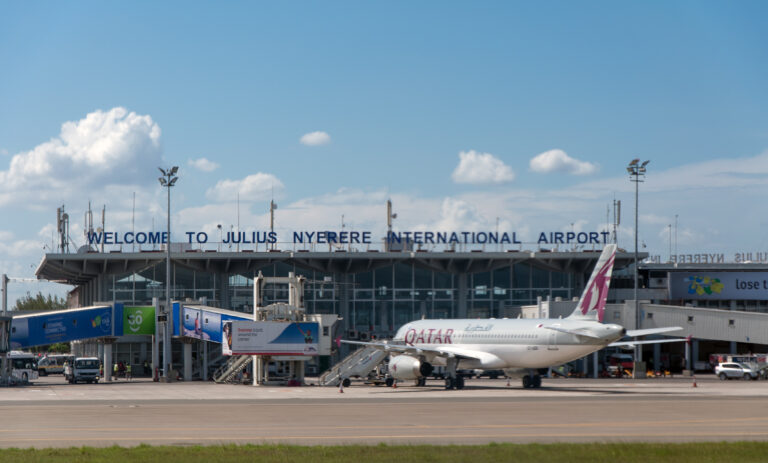Dar es Salaam. Tanzania’s aviation sector has recorded another milestone, with both Zanzibar and Dar es Salaam airports ranked among Africa’s top 10 busiest as of July 2025, underlining the country’s rising profile as a travel and tourism hub.
According to aviation analytics platform Flightsfrom.com, Zanzibar’s Abeid Amani Karume International Airport (ZNZ) handled an average of 92 flights daily, making it the ninth busiest airport on the continent.
Julius Nyerere International Airport (JNIA) in Dar es Salaam followed closely in tenth place, with 84 flights per day.
The latest ranking places Tanzania alongside continental heavyweights such as Johannesburg, Cairo, Addis Ababa, Nairobi, and Lagos, reflecting not only a recovery of air travel post-pandemic but also a transformation in Tanzania’s aviation and tourism landscape.
Expansion and modernisation
The growth of Tanzania’s airports is the result of sustained investment in infrastructure aimed at boosting passenger capacity, efficiency, and connectivity.
In Zanzibar, the commissioning of the new Terminal 3 has been a game-changer, significantly raising the island’s ability to handle the surge in international arrivals.
The facility, designed to accommodate over four million passengers annually, has helped reposition Zanzibar as a premier global destination, particularly popular with European, Middle Eastern, and Asian carriers.
Meanwhile, Julius Nyerere International Airport has undergone major upgrades, including the completion of Terminal 3, which caters to international flights.
With its modern check-in facilities, expanded passenger lounges, and increased apron capacity, the terminal has enhanced Tanzania’s ability to attract long-haul carriers and facilitate transit traffic.
Government officials have consistently underscored that airport expansion projects form part of a broader strategy to support the growth of the tourism industry and the wider economy.
Tourism at the heart of growth
Tourism continues to be the primary driver of air traffic into Tanzania.
The country welcomed over 1.8 million tourists in 2023, a sharp increase from the pandemic years, with Zanzibar emerging as a star attraction thanks to its pristine beaches, cultural heritage, and expanding luxury hotel sector.
By 2024, official statistics indicated that Zanzibar alone contributed nearly 40 percent of Tanzania’s total tourist arrivals, a shift that explains the island airport’s elevated position in continental rankings.
Airlines such as Qatar Airways, Turkish Airlines, and FlyDubai have expanded frequencies to Zanzibar, while charter operators from Italy, Poland, and Russia have also strengthened the island’s direct connections.
Dar es Salaam, as Tanzania’s commercial capital, remains the country’s key gateway for business travellers, regional connections, and outbound passengers.
Its growth has also been fuelled by increasing intra-African connectivity, with airlines such as Ethiopian Airlines, Kenya Airways, and Air Tanzania expanding regional routes to serve rising trade and investment flows.
Past surveys and shifting trends
The prominence of Tanzanian airports in 2025 marks a sharp shift from historical trends.
Earlier surveys consistently placed Dar es Salaam as the dominant hub in the country, but the rise of Zanzibar reflects a changing travel dynamic.
In 2019, for instance, prior to the pandemic, JNIA handled over 3.5 million passengers, compared to around 1.5 million in Zanzibar.
However, in recent years, Zanzibar’s accelerated tourism boom has narrowed this gap, with its airport now surpassing Dar es Salaam in daily flight operations, a feat that seemed unlikely a decade ago.
Industry analysts point out that this trend illustrates the diversification of Tanzania’s tourism product, with Zanzibar becoming a destination in its own right rather than simply an extension of mainland itineraries.
Aviation as an economic catalyst
The surge in airport traffic has broader economic implications for Tanzania.
Increased flight frequencies translate into higher revenues from passenger services, aviation fees, and airport operations, while also boosting allied industries such as hospitality, logistics, and ground transport.
Furthermore, the strengthening of Tanzanian airports on the African map aligns with government ambitions to turn the country into a strategic regional hub.
The state-owned Air Tanzania Company Limited (ATCL) has been steadily expanding its fleet and destinations, with the delivery of Boeing 787 Dreamliners and Airbus A220s enabling the airline to open new long-haul routes.
Analysts believe that maintaining this momentum will depend on continued investment in airport infrastructure, regulatory reforms, and the ability to diversify beyond tourism by tapping into cargo, business travel, and regional hub opportunities.
With Zanzibar and Dar es Salaam both securing a place in Africa’s busiest airports ranking, Tanzania has demonstrated that strategic investment in aviation pays off.
The challenge ahead lies in sustaining this growth, ensuring seamless passenger experiences, and deepening connectivity that will allow the country to leverage its geographical advantage in the global air travel network.







